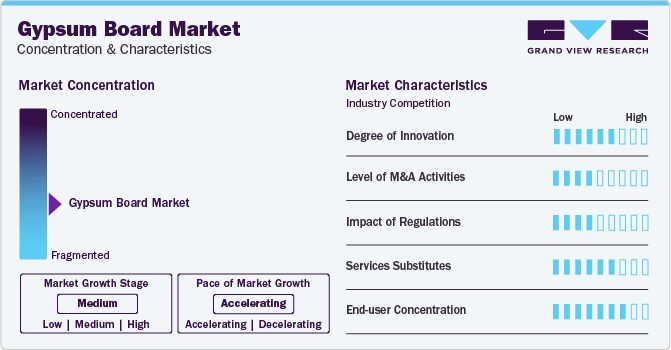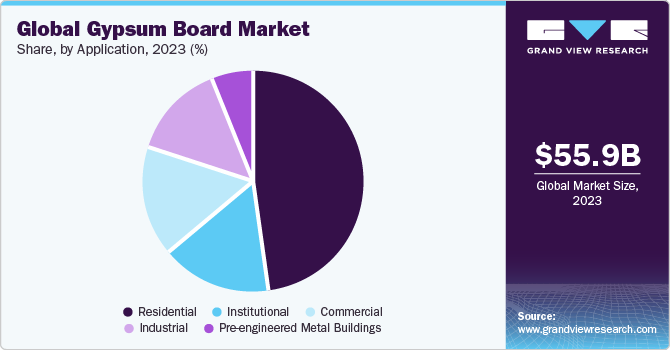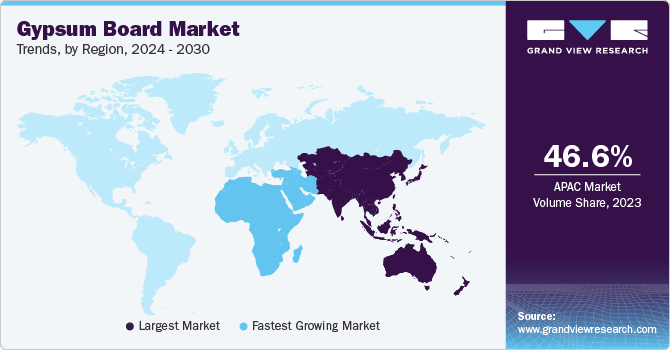- Home
- »
- Advanced Interior Materials
- »
-
Gypsum Board Market Size & Share Analysis Report, 2030GVR Report cover
![Gypsum Board Market Size, Share & Trends Report]()
Gypsum Board Market (2024 - 2030) Size, Share & Trends Analysis Report By Product (Wallboard, Ceiling Board, Pre-Decorated), By Application (Pre-engineered Metal Building, Residential, Industrial), By Region, And Segment Forecasts
- Report ID: 978-1-68038-722-3
- Number of Report Pages: 130
- Format: PDF
- Historical Range: 2018 - 2022
- Forecast Period: 2024 - 2030
- Industry: Advanced Materials
- Report Summary
- Table of Contents
- Segmentation
- Methodology
- Download FREE Sample
-
Download Sample Report
Gypsum Board Market Summary
The global gypsum board market size was estimated at USD 55.91 billion in 2023 and is projected to reach USD 127.06 billion by 2030, growing at a CAGR of 12.7% from 2024 to 2030. The market is anticipated to be driven by increasing residential and commercial construction spending in developing regions of Asia Pacific, such as China, India, and Indonesia, coupled with strong economic growth in the aforementioned regions.
Key Market Trends & Insights
- Asia Pacific accounted for the largest market share of 46.6% in terms of volume in 2023.
- China is expected to witness an increased demand for gypsum board over the forecast period.
- By product, wallboard emerged as the leading gypsum board product segment by accounting for a 50.3% market share in 2023.
- By application, pre-engineered metal buildings segment are expected to grow at a CAGR of 12.9% over the forecast period.
Market Size & Forecast
- 2023 Market Size: USD 55.91 Billion
- 2030 Projected Market Size: USD 127.06 Billion
- CAGR (2024-2030): 12.7%
- Asia Pacific: Largest market in 2023
- Middle East & Africaa: Fastest growing market
The U.S. market is expected to witness sustainable growth over the forecast period owing to the growth in construction sector in the country. Increased demand for energy-efficient construction solutions is one of the primary factors driving the market growth. In addition, increased incidents of natural calamities, including hurricanes and wildfires, hitting different parts of the U.S. are anticipated to have a positive effect on construction sector in the country, thereby driving the demand for gypsum board over the forecast period.Developed regions such as North America and Europe are expected to witness significant growth due to the recovery of the housing sector post-recession. The U.S. is expected to remain a key market in gypsum board over the forecast period owing to increasing wallboard usage in non-load-wearing walls and suspended ceilings.

Gypsum board is being widely used in the construction industry owing to properties such as fire resistance, sound attenuation, and durability. Developed through modern technology to meet specific requirements, it is mainly used as the surface layer of interior walls and ceilings; as a base for ceramic, plastic, and metal tile; for exterior soffits; for elevator and other shaft enclosures; as area-separation walls between building units; and to provide fire protection for structural elements. Most gypsum boards are available with aluminum foil backing that provides an effective vapor retarder for exterior walls when the foil surface is applied against the framing.
Players in the gypsum board industry are involved in the distribution of products through direct and third-party distribution channels. Key companies in the market operate their businesses through direct sales that are carried out by the manufacturers themselves. In addition, companies are also involved in the third party distribution which is carried out majorly to reduce the operational and logistics cost.
Market Concentration & Characteristics
Market growth stage is medium, and pace of the market growth is accelerating. Technological advances and the development of novel, innovative production processes by major industry players have driven gypsum board growth in recent years. Plasterboard Sustainability Partnership (PSP) has formulated a Gypsum Sustainability Action Plan in order to promote improvement of environmental performance of various gypsum board products across their lifecycle.

The market is also characterized by a high level of merger and acquisition (M&A) activity by the leading players. This initiative is taken by manufacturers in order to expand their product portfolio as well as to cater to the demand from different regions across the globe.
The market is governed by various regulations and standards related to its production, application, and trade. Furthermore, product has several substitutes available in the market commercially. Some of the prominent substitutes of the product include basement wall finishing, wool wall panels, veneer plaster, and plywood.
Product Insights
Wallboard emerged as the leading gypsum board product segment by accounting for a 50.3% market share in 2023. Wallboard is widely used in construction industry for various interior applications such as walls or partitions. Increasing demand for sustainable construction in North America and Europe is expected to drive product demand over the forecast period. Wallboard also emerged as a speedier alternative to traditional lath and plaster.

Industrialized nations such as the U.S. are primarily using gypsum for manufacturing wallboard products. However, developing countries, including the Middle East and Asia Pacific, are using most of the gypsum for the production of plaster products or cement. Rapidly growing construction industry, specifically in Asia Pacific and Middle East, owing to urbanization, rising disposable income, and increased housing demand from the burgeoning population, is anticipated to boost wallboard demand in various construction projects.
Pre-decorated boards are expected to grow at the highest CAGR over the forecast period. Pre-decorated boards are gaining wide acceptance in various construction projects owing to their low maintenance and easy installation properties, which makes them cost and time effective. These gypsum boards are widely utilized in commercial applications since they provide flexibility to changing workspace configuration whilst offering maximum stability and color retention to surfaces.
Pre-decorated boards require special care during storage and handling inside the warehouse or other suitable structures wherein they are not exposed to weather or to temperatures exceeding. Growing focus on environmentally sustainable green building construction materials, which reduces overall overhead expenses, is the key factor driving pre-decorated board industry growth.
Application Insights
The residential segment dominated the market in 2023. Increasing urban population coupled with increasing per capita disposable income is anticipated to remain the key driving factor for end-use segment growth over the forecast period. China, India, Brazil and Saudi Arabia are anticipated to witness significant residential construction spending over the forecast period.
The most common gypsum board product utilized in residential applications is wallboard, in which the joints between the panels and internal corners are reinforced with tape and covered with joint compound to create a surface suitable for final decoration. Population expansion coupled with rapid urban migration is anticipated to fuel residential construction spending in countries such as China, India and Brazil over the forecast period. The U.S. residential housing industry also witnessed rapid growth rate in recent years owing to easy access to home mortgage loans, continued employment growth, rising demand for apartments and burgeoning population.
Pre-engineered metal buildings are expected to grow at a CAGR of 12.9% over the forecast period. PEB’s are growing at an impressive growth rate of over 25% in India owing to their wide application scope and exceptional inherent characteristics such as easy installation, low cost maintenance and easy transportation to other manufacturing sites. Gypsum board is widely used in PEBs in roofing and external wall applications. It is most commonly used in industrial structures, since it facilitates easy fitting in windows and doors whilst providing security. Some other properties of PEBs making it a preferred building material in comparison with other conventional alternatives such as steel, are lightweight, design flexibility, economical and easy fabrication.
Pre-engineered metal buildings are essentially rectangular boxes enclosed in a skin of corrugated metal sheeting, which are factory-built and are shipped to the site and bolted together. The concept of these building materials has largely been benefitted by the technological advancement in recent years, which helped in computerizing their design and producing tailor made solutions. These high performance materials are very popular in the U.S. market, wherein 60% non-residential buildings are pre-engineered buildings (PEBs). However, it is a relatively new concept in emerging economies such as India.
Regional Insights
Asia Pacific accounted for the largest market share of 46.6% in terms of volume in 2023. Market in the region is characterized by high demand for gypsum boards in residential and corporate construction applications. China is expected to witness an increased demand for gypsum board over the forecast period owing to growing urbanization in China, which is one of the primary factors boosting the growth of construction sector and, consequently, the demand for gypsum board.

Middle East & Africa is expected to grow at the highest CAGR in terms of revenue over the forecast period owing to rapid demand in countries such as Oman, Saudi Arabia, Jordan, and Qatar. Major economies are focusing on expanding their production capabilities in order to cater to growing construction markets in the Middle East and Africa region. This trend is positively influencing gypsum board demand across the region.
Key Gypsum Board Company Insights
Some of the key players operating in the market include Beijing New Building Material (BNBM) Public Ltd Co., Saint-Gobain Gyproc, and Lafarge Group.
-
Saint-Gobain Gyproc is a UAE-based gypsum board manufacturer with its operational base in Abu Dhabi. As a subsidiary of Saint-Gobain, the company was established as Gyproc Middle East in 2005. In Middle East, the company's product portfolio includes gypsum plasterboards, Gypframe metal components, Gyproc accessories, and GypFine plaster. These products have been catered to construction applications in Dubai Metro, Palm Jumeirah, Capital Gate, Ferrari Experience and Masdar Institute.
-
Beijing New Building Material (BNBM) Public Ltd Co. was established in 1979 and is headquartered in China. The company is engaged in the production of gypsum and other construction product. It caters its products to the construction industry across the globe. Annual production capacity of the company is more than 1470 million square meters.
National Gypsum Company and Global Mining Company LLC (GMC) are some of the emerging market participants in the gypsum board market.
-
National Gypsum Company is engaged in manufacturing and supply of gypsum boards and other construction products. It caters its products to construction applications across the globe. Company's product portfolio includes gypsum boards, finishing products, cement boards, plaster systems, and roofing systems, along with other industrial products.
-
Global Mining Company LLC (GMC) is engaged and specializes in the rocks & minerals business. It operates three subsidiaries, including Global Gypsum Company LLC, Global Gypsum Board Company LLC, and Global Marble Manufacturing Company LLC. The company owns a quarry at Thumrait state to produce natural gypsum.
Key Gypsum Board Companies:
The following are the leading companies in the gypsum board market. These companies collectively hold the largest market share and dictate industry trends. Financials, strategy maps & products of these gypsum board companies are analyzed to map the supply network.
- USG Zawawi Drywall LLC SFZ
- Knauf
- Gypsemna
- Global Mining Company LLC (GMC)
- Gulf Gypsum Co. (ASK Gypsum Factory Ltd.)
- National Gypsum Company
- Beijing New Building Material (BNBM) Public Ltd Co.
- Extex Group
- United Mining Industries (UMI) Company Ltd.
- Saint-Gobain Gyproc
- Lafarge Group
- Ahmed Yousef & Hassan Abdulla Co. (AYHACO)
- Yoshino Gypsum Co. Ltd.
Recent Developments
-
In December 2023, Saint-Gobain Gyproc launched its new product line which is inclusive of gypsum wallboards. The company made an addition to existing segments with Habito Standard, a gypsum wallboard suitable for planned and unplanned heavy loading applications, a Glasroc X for exterior applications, and Rigiroc, a moisture resistance board for multipurpose applications.
-
In May 2023, Chiyoda-Ute announced its plans to launch a new gypsum board, which will utilize 100% recycled gypsum gathered from construction sites to produce the product. Furthermore, the manufacturing of Chiyoda Circular Gypsum will be carbon neutral.
Gypsum Board Market Report Scope
Report Attribute
Details
Market size value in 2024
USD 62.04 billion
Revenue forecast in 2030
USD 127.06 billion
Growth rate
CAGR of 12.7% from 2024 to 2030
Base year for estimation
2023
Historical data
2018 - 2022
Forecast period
2024 - 2030
Report updated
January 2024
Quantitative units
Volume in million square meters; revenue in USD million/billion, and CAGR from 2024 to 2030
Report coverage
Volume forecast, revenue forecast, company ranking, competitive landscape, growth factors, trends
Segments covered
Product, application, region
Regional scope
North America; Europe; Asia Pacific; Central & South America; MEA
Country scope
U.S.; Canada; Mexico; UK; Germany; Russia; India; China; Japan; South Korea; Brazil; Saudi Arabia; UAE
Key companies profiled
USG Zawawi Drywall LLC SFZ; Knauf; Gypsemna; Global Mining Company LLC (GMC); Gulf Gypsum Co. (ASK Gypsum Factory Ltd.); National Gypsum Company; Beijing New Building Material (BNBM) Public Ltd Co.; Extex Group; United Mining Industries (UMI) Company Ltd.; Saint-Gobain Gyproc; Lafarge Group; Ahmed Yousef & Hassan Abdulla Co. (AYHACO); Yoshino Gypsum Co. Ltd.
Customization scope
Free report customization (equivalent up to 8 analysts working days) with purchase. Addition or alteration to country, regional & segment scope.
Pricing and purchase options
Avail customized purchase options to meet your exact research needs. Explore purchase options
Global Gypsum Board Market Report Segmentation
This report forecasts volume and revenue growth at global, regional, and country levels and provides an analysis of the latest industry trends in each of the sub-segments from 2018 to 2030. For this study, Grand View Research has segmented the global gypsum board market report based on product, application, and region:

-
Product Outlook (Volume, Million Square Meters; Revenue, USD Billion, 2018 - 2030)
-
Wallboard
-
Ceiling Board
-
Pre-decorated Board
-
Others
-
-
Application Outlook (Volume, Million Square Meters; Revenue, USD Billion, 2018 - 2030)
-
Pre-engineered Metal Buildings
-
Residential
-
Industrial
-
Commercial
-
Institutional
-
-
Regional Outlook (Volume, Million Square Meters; Revenue, USD Billion, 2018 - 2030)
-
North America
-
U.S.
-
Canada
- Mexico
-
-
Europe
-
U.K.
-
Germany
-
Russia
-
-
Asia Pacific
-
China
-
India
-
Japan
-
South Korea
-
-
Latin America
-
Brazil
-
-
Middle East & Africa
-
Saudi Arabia
-
UAE
-
-
Frequently Asked Questions About This Report
b. The global gypsum board market size was estimated at USD 55.91 billion in 2023 and is expected to reach USD 62.04 billion in 2024.
b. The gypsum board market is expected to grow at a compound annual growth rate of 12.7% from 2024 to 2030 to reach USD 127.06 billion by 2030.
b. Ceiling board accounted for the largest product segment with a revenue share of 23.8% in 2023 as the product is increasingly replacing other conventional counterparts including plaster in ceilings and interior walls.
b. Some of the key players operating in the gypsum board market include USG Zawawi Drywall LLC SFZ, Knauf, Gypsemna, Global Mining Company LLC (GMC), Gulf Gypsum Co. (ASK Gypsum Factory Ltd.), National Gypsum Company, Beijing New Building Material (BNBM) Public Ltd Co., and Extex Group.
b. The key factors that are driving the gypsum board market includes increasing residential and commercial construction spending in developing regions such as Asia Pacific and North America coupled with strong economic growth in aforementioned regions.
Share this report with your colleague or friend.
Need a Tailored Report?
Customize this report to your needs — add regions, segments, or data points, with 20% free customization.

ISO 9001:2015 & 27001:2022 Certified
We are GDPR and CCPA compliant! Your transaction & personal information is safe and secure. For more details, please read our privacy policy.
Trusted market insights - try a free sample
See how our reports are structured and why industry leaders rely on Grand View Research. Get a free sample or ask us to tailor this report to your needs.










